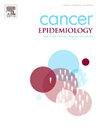Long-term environmental background radiation is associated with urinary tract cancer incidence: A population-based study from Finland
IF 2.3
3区 医学
Q3 ONCOLOGY
引用次数: 0
Abstract
Background
The long-term carcinogenic effects of natural radioactive elements in the environmental background on urinary tract cancer (UTC) have not been fully investigated in the general population.
Methods
The entire Finnish population was linked to long-term municipality-level data on concentrations of uranium and radon in water and radon in indoor air by residential location annually between 1987 and 2016, and UTC incidence was tracked until 2021 based on multiple registries. The first principal component (PC1) of the three radiation exposures was used as a proxy for radiation exposure, and was assessed using the Cox proportional hazards model for its association with UTC risk. Age-standardized incidence rates (ASR) and population attributable fractions (PAF) of radiation exposure were estimated. Spatial association between regional radiation exposure and UTC risk was assessed.
Results
Among a total of 2,816,495 residents with 30-year exposure data, 6718 primary UTC cases were diagnosed during 2017–2021. UTC risk increased significantly with each standard deviation (SD) increase in PC1 (hazard ratio [HR] = 1.05, 95 %CI 1.02–1.07). Dose-response relationship was observed when exposure was modelled via natural cubic splines. Increasing UTC incidence was observed across exposure quintiles (lowest quintile: ASR = 47, 95 % CI 45–50; highest quintile: ASR = 53, 95 %CI 50–55). About 5.1 % (PAF, 95 %CI 0.5 %–9.7 %) of UTC incidence was attributable to radiation exposure. Stronger association (HR=1.06, 95 %CI 1.03–1.09, per 1-SD increase) and attributable fraction (PAF = 9.0 %, 95 %CI 3.2 %–14.8 %) were observed among men than among women. Regional UTC risk was significantly associated with regional radiation exposure adjusted for the spatial lag effect in the total population (β = 0.08, p < 0.01), men (β = 0.07, p < 0.01) and women (β = 0.1, p = 0.02).
Conclusion
Association between long-term environmental radiation exposure and UTC risk was observed in the Finnish population. Dose-response patterns were observed, especially among men. UTC risks attributable to radiation exposure and geographical patterns warrant further investigations.
长期环境本底辐射与尿路癌发病率相关:芬兰一项基于人群的研究
环境背景中天然放射性元素对尿路癌(UTC)的长期致癌作用尚未在普通人群中得到充分研究。方法在1987年至2016年期间,所有芬兰人口每年都与按居住地点划分的市级水和室内空气中铀和氡浓度的长期数据相关联,并基于多个登记跟踪UTC发病率至2021年。使用三种辐射暴露的第一主成分(PC1)作为辐射暴露的代表,并使用Cox比例风险模型评估其与UTC风险的关联。估计辐射暴露的年龄标准化发病率(ASR)和人口归因分数(PAF)。评估了区域辐射暴露与UTC风险之间的空间关联。结果在共有2,816,495名具有30年暴露数据的居民中,2017-2021年期间诊断出6718例原发性UTC病例。随着PC1每增加一个标准差(SD), UTC风险显著增加(风险比[HR] = 1.05, 95 %CI 1.02-1.07)。通过自然三次样条模拟暴露时,观察到剂量-反应关系。暴露五分位数中观察到UTC发病率增加(最低五分位数:ASR = 47, 95 %CI 45-50;最高五分位数:ASR = 53, 95 %CI 50-55)。约5.1 % (PAF, 95 %CI, 0.5 % -9.7 %)的UTC发病率可归因于辐射暴露。男性比女性有更强的相关性(HR=1.06, 95 %CI 1.03-1.09,每增加1-SD)和归因分数(PAF = 9.0 %,95 %CI 3.2 % -14.8 %)。区域UTC风险与总人口(β = 0.08, p <; 0.01)、男性(β = 0.07, p <; 0.01)和女性(β = 0.1, p = 0.02)的区域辐射暴露显著相关。结论:在芬兰人群中观察到长期环境辐射暴露与UTC风险之间的关联。观察到剂量-反应模式,特别是在男性中。可归因于辐射暴露和地理模式的UTC风险值得进一步调查。
本文章由计算机程序翻译,如有差异,请以英文原文为准。
求助全文
约1分钟内获得全文
求助全文
来源期刊

Cancer Epidemiology
医学-肿瘤学
CiteScore
4.50
自引率
3.80%
发文量
200
审稿时长
39 days
期刊介绍:
Cancer Epidemiology is dedicated to increasing understanding about cancer causes, prevention and control. The scope of the journal embraces all aspects of cancer epidemiology including:
• Descriptive epidemiology
• Studies of risk factors for disease initiation, development and prognosis
• Screening and early detection
• Prevention and control
• Methodological issues
The journal publishes original research articles (full length and short reports), systematic reviews and meta-analyses, editorials, commentaries and letters to the editor commenting on previously published research.
 求助内容:
求助内容: 应助结果提醒方式:
应助结果提醒方式:


